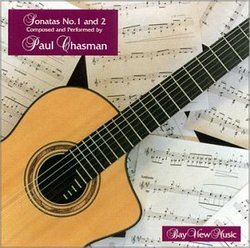| All Artists: Paul Chasman Title: Sonatas No. 1 and 2 for Guitar Members Wishing: 0 Total Copies: 0 Label: Bay View Music Original Release Date: 12/1/1998 Release Date: 12/1/1998 Genres: Special Interest, Pop, Classical Style: Easy Listening Number of Discs: 1 SwapaCD Credits: 1 UPC: 603831000326 |
Search - Paul Chasman :: Sonatas No. 1 and 2 for Guitar
 | Paul Chasman Sonatas No. 1 and 2 for Guitar Genres: Special Interest, Pop, Classical
|
Larger Image |
CD DetailsSimilar CDs |
CD ReviewsGuitar Wizardry Chris Hager | Portland, OR USA | 08/16/2000 (5 out of 5 stars) "Sonatas No. 1 and 2 These sonatas are timeless. They are perfect. They are so enchanting that people will be listening to them for centuries to come. We are lucky, however, to be living and listening to them today for two reasons. First, we can listen to this music while Paul Chasman is still alive and expressing his artistry. On this CD we can hear the sonatas interpreted as the composer intended. And we theoretically could say to our friends 300 years from now that we discovered Paul Chasman and his music while he was still alive and undiscovered by the masses. Second, if we were not living and listening today, we'd be dead.Sonata No. 2 This sonata is modern baroque music - modern only in the sense that both it and Sonata No. 1 were written in the late 1990's, and baroque in that it sounds as if it had been written in the 1690's. This sonata takes one back a few centuries, back to the days when sonatas had four movements, not two or three. If Bach were alive today, this is the music he would be writing for the guitar. Conversely, this music is what people 300 years from now will be listening to. Coincidentally, the "Big Guy" referred to in the title of the first movement is J. S. Bach. Bach isn't dead; he is alive and well in the first movement: Here, the theme unfolds in D minor until measure 25 where it glides into A minor. In measure 44 is a shift in the presentation of the theme, arpeggiated chords hinting at a return to the key of D minor, but instead leading to a D-major restatement of the theme. This restatement ingeniously modulates from major to minor to major until its final return to the original theme in D minor. It's brilliant! The second movement, Tears, also begins in D minor. A four measure rubato introduction in four-four time gracefully gives way to a dreamy andante melody in eleven-four time carried in the bass line, accompanied by a remarkably well-executed succession of sixteenth-note treble statements. The introductory statement returns in measures 28, 44, and 62 to help the listener get a bearing before continuing with variations of the andante segment. I wish this movement were longer. The third movement, Waltz in the Morning Mist, is so beautiful and evocative that it nearly brings me to tears. The movement starts in D minor, which gives it a somber feeling not conducive to waltzing at all (at least not by humans, though I can imagine mischievous elves prancing about). Paul's ingenious use of eighth-note and sixteenth-note triplets produces the perception that what's really doing the waltzing here is the melody. By measure 63, the melody has whirled its way to the key of E-minor, but in key signature only: The melody so gracefully flits through modulation after captivating modulation that the listener engages with the magic of this waltz. Sonata No. 2 finishes with a movement entitled All of the Above. This movement is a recapitulation of all three preceding movements. Beginning in F major, this movement also uses the Baroque bass line set against a light and lively allegro melody line in which Paul's intriguing use of triplets reappears. Again, the melody modulates, from F major to C major to G minor. When it returns to F major, the music begins to build its finale with a gradual crescendo and accelerando through the last 44 measures. The building is so dynamic that when the final chord is played, the listener may throw his hands above his head and shout, "Yes!"Sonata No. 1 Sonata No. 1, which inexplicably appears on this CD after Sonata No. 2, has a more modern, less Baroque flavor. It begins with Dark Dance, a rubato exploration of darkness in five-four time. Part of this movement's darkness comes from its struggle between major and minor modes, but for me its unsettling effect derives from the melody's unwillingness to confine itself to a discernible time signature. Just as I begin to feel at home with the cadence, Paul employs measures of dotted quarters and the melody seems to stagger. And then when the piece actually changes to three-four time in measure 131, I feel as though I am being mocked. These devices keep the listener off balance yet never completely toppled. These cadence devices work amazingly well to produce a feeling of disquietude. The disquietude is increased by the bass line fighting with the treble line for the melody. In addition, when the piece attempts to return to its original major theme of lightness from the opening measures, the attempts are subverted by minor modulations. Darkness may be dancing with light, but in this piece, darkness definitely leads. The development of the exposition set out in the first movement continues in the second movement, Emerging. Here, light and darkness are more equal partners in a five-four dance. I am in love with the chord in the middle of measure 40 (and again in measure 77). It's made up of, from top to bottom, A, E, D#, G, & F. Nowhere else in the music world would this chord make sense but here. If for no other reason, get this CD to hear this chord. The third movement, In Waltzed Anna, is the harbinger of the impending triumph of light over darkness. This piece sounds as though it were lifted straight out of Anna's Notebook - only the "Anna" eluded to in the title is Anna Wiancko-Chasman, Paul's wife, not Anna Magdalena, Bach's second wife. The melody still begins on the melancholy side of things, but the waltz time signature is familiar and reassuring. Midway through the piece there is a full ten-measure section with nary a flatted third to be found. Rejoice! The dawn cometh! Light, the fourth and final movement, is a celebration of light in A major. It's a fiery allegro "J. S. Bach meets Scott Joplin" piece in five-four time. Darkness though is not banished completely. It makes a cameo reappearance in the form of eighth notes grouped into cadence-breaking tuplets, leading into a G-minor recapitulation of an earlier theme. The final struggle between light and darkness is announced by a key change to C major and by a run of pleasant-sounding groups of tuplet and duplet eighth notes alternating between major, minor, and ambiguous musical statements. With a final key change to A major, the piece races into the light without ever turning back. The fourth movement is a magnificent piece of work and could stand entirely on its own, but should be heard in the context of the other movements to be fully appreciated. A final plus here is that Sitka and Clyde are pictured on the back of the CD insert (Sitka and Clyde is the title of one of the cello/guitar duets on Paul's Songs from the Bay). See if you can guess which is which (Hint: Clyde is portrayed by the cello)."
|

 Track Listings (8) - Disc #1
Track Listings (8) - Disc #1


